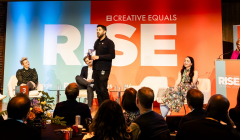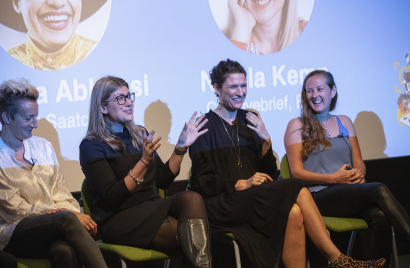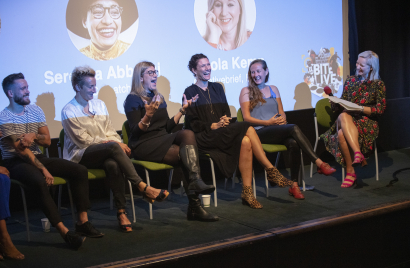
Are we leaving men and boys behind?
At Creative Equal’s RISE event, industry leaders consider how to reframe boys and men in marketing

From active listening to making the space for communities to tell their own stories, industry leaders at #BITELIVE19 delivered practical insight into how to smash stereotypes.

“Lots of creative companies are trying to make sure we are portraying a more diverse and inclusive Britain in our output. There is a willingness to show more diverse people, but there is a fear of getting it wrong.” With absolute precision Sara Tate, CEO of TBWA\London identified the ‘fear factor’ which is holding brands back when it comes to translating the talk on diversity and inclusion into meaningful action.
In a lively and wide-ranging debate, the panellists each brought their own experience to the conversation around how to move from talk to action on breaking stereotypes and building a more inclusive industry. They identified the key challenges that face the industry, as well as suggesting tangible ways and practical examples of how to overcome them. Here are some of the key takeaways.
There is a willingness to show more diverse people, but there is a fear of getting it wrong.
Sara Tate
The need to leave your ego at the door was top of the agenda for TBWA\London’s Tate who shared how Dan Kenny, one of the creative leads on the agency’s ground-breaking ‘Steal our Staff’ campaign for BECO. had urged her to “tell people you can’t bring your own slant to it.” It’s an approach that you don’t often hear from creative directors.
The whole creative idea changed because Kenny had spent so much time at the BECO. offices and the resulting campaign had its creative roots in the amount of time he had spent in reception at the organisation hearing about audio-description. The agency also spoke to seven different disability organisations to get feedback throughout the process.
This uniquely ego-less creative process not only allowed TBWA\London not to stereotype the disabled people who appeared in the advert, but also to deliver better creative work. As Tate explained, “It’s the crucible of what we should be doing as an industry; it’s more ears and less mouth. We get things right and wrong, but listening to clients, the business, their needs and the staff got us there.”
Camilla Marcus-Dew, Co-Founder of The Soap Co and BECO., shared that this inclusive approach had led to the brand achieving 23 million impressions on the campaign with a media budget of £3,000. “People are going above and beyond to share something they think is valuable,” she explained. She added that the campaign underlined the power of the industry to use its influence for good.
Yet realising this potential requires the industry to step back and listen to the communities it is seeking to connect with. As Marcus-Dew encouraged, “Come see people, come hear people’s stories. We can do it really well through digital platforms but come and have a cup of tea with us. Let’s go a step further and say active listening."
The importance of overcoming unconscious bias and assumption also topped the agenda. Charly Lester, Co-Founder and CMO of Lumen, a dating app for the over 50’s, noted that older people are often stereotyped. She explained, “Our target age group is 50 to 65. If you look at ads and media, over 50 tends to be 70 or 80 on beaches retired. It’s like a whole generation has been forgotten.”
She noted that when most younger people think of a 50-year-old they are actually thinking about 70-year-olds. It’s a lack of understanding which also translates into poor product experiences. Lester noted that older people were often trying to date on millennial products and having a “really miserable experience”.
Lester added, “The reality is that people have sex for as long as they can and the older you get the differential between how old you feel and how old you are only increases."
It’s the small decisions on things that aren’t big brand campaigns that helps to move the visual language on.
Dr Rebecca Swift
The importance of micro-actions to deliver tangible change on diversity was put into the spotlight by Dr Rebecca Swift, Global Head of Creative Insights at Getty Images. She explained, “Even if you are making decisions about what images to put into your PowerPoint, or your document or report; it’s the small decisions on things that aren’t big brand campaigns that helps to move the visual language on.”
According to Swift, there comes a moment in the decision-making process where someone needs to stick their neck out, perhaps changing the visual language they have been using over the last 20 years. She believes this can be challenging, especially if the person having to make that decision is not the most senior person in their organisation. She added that it can be both a lack of conviction or a lack of data that is potentially holding back the pace of change.
However, Swift pointed to work such as the recent Sainsbury’s TU campaign as evidence of the positive shift afoot in how women in advertising are depicted as well as the celebratory change that can happen when women are given the control and tools to build their own visual narrative.
She added, “I don’t want photographers doing what they have been doing for the last twenty years. It is dull and morally wrong.”
Swift challenged brands and agencies to ask themselves how they can be as inclusive as they can possibly be and then focus on making a real difference. She noted that mainstream advertising was “behind the curve” when it comes to the depiction of age, and agencies and media owners alike need to encourage brands to make a difference.
The importance of building a business case for diversity also topped the agenda. Rich Miles, Founder of What’s Normal and the Diversity Standards Collective, pointed to the fact that 57% of the London population is BAME, a statistic not reflected in either the make-up of the creative industries or their output. He explained, “There are lots of communities that aren’t being accessed and in turn aren’t being valued.”
“There are a lot more people that aren’t bothered [about diversity and inclusion] so my job is to use data to show them why they should be,” he added.
The commercial imperative for diversity was also underlined by TBWA\London’s Tate, who shared how the agency talks to clients about the spending power of different communities. Pointing to the spending power of disabled people, or the ‘purple pound’, she urged the industry to talk to clients about the spending power of these marginalised audiences.
In addition, she shared the importance of hiring in a more inclusive way, pointing to the work of Sam Phillips, Chair of OPEN (Omnicom People Engagement Network) in driving this conversation across the entire Omnicom network. It’s a focus which has led the agency to consider neurodiversity for example when hiring, noting that neurodiverse people can perform better in specific roles. She added, “Talk to an organisation about the commercial benefits and brilliance that come with inclusive hiring.
There are lots of communities that aren’t being accessed and in turn aren’t being valued.
Rich Miles
A core challenge for building the business case for diversity was identified as the lack of shared data across the industry. Serena Abbassi, Worldwide Head of Culture and Inclusion at M&C Saatchi, urged the audience to speak the language that people in position in power will understand: “First and foremost it is the data that is driving the business imperative.”
The panel agreed that there is not currently a great deal of sharing across the industry because of its innately competitive nature. Miles noted that this competitiveness can lead to working in quite an insular way. He pointed to the power of actually asking for help, reaching out and engaging with the communities you represent in advertising. This is key to success.
“What does it mean [for the brand and creative team] to not be author of someone’s story, to sit back and listen...we don’t see enough of that,” noted Miles. He urged the audience to better understand how big the audiences are and underlined why it is essential to really understand communities.
He pointed to example of a brand using one transgender person in an advert, getting their opinion on the ad they are being paid to appear in, and using that as a proxy for proper research into an entire community they have no previous experience or understanding of.
Miles added, “If you don’t let people tell their own stories, you won’t get the truth. That’s why we need to stand back and let people tell their stories.”
The importance of not thinking about diversity as a separate entity to a campaign you are creating was another key theme of the panel. Factoring in time to connect with communities that brands seek to connect with and represent was seen as key to achieving this goal.
The challenge for changemakers not at the top of businesses who are seeking to move the dial on diversity and inclusion was also addressed by Abbassi who noted that “change won’t happen until people at the top are really committed to it.” She urged the audience to make their own “beautiful web of influence” to make a positive impact on both the industry and the work they create.
Photography © Steve Brown


Looks like you need to create a Creativebrief account to perform this action.
Create account Sign inLooks like you need to create a Creativebrief account to perform this action.
Create account Sign in